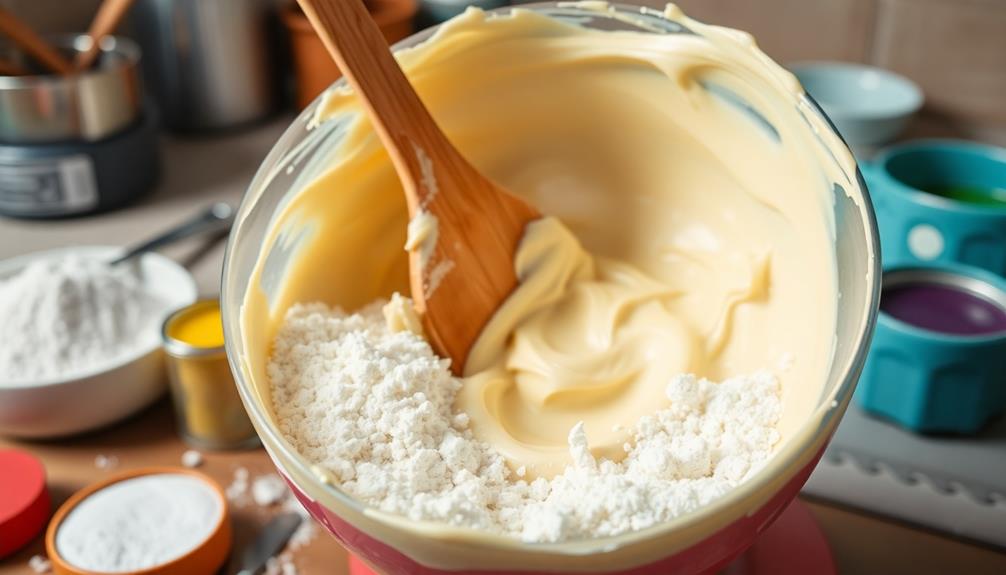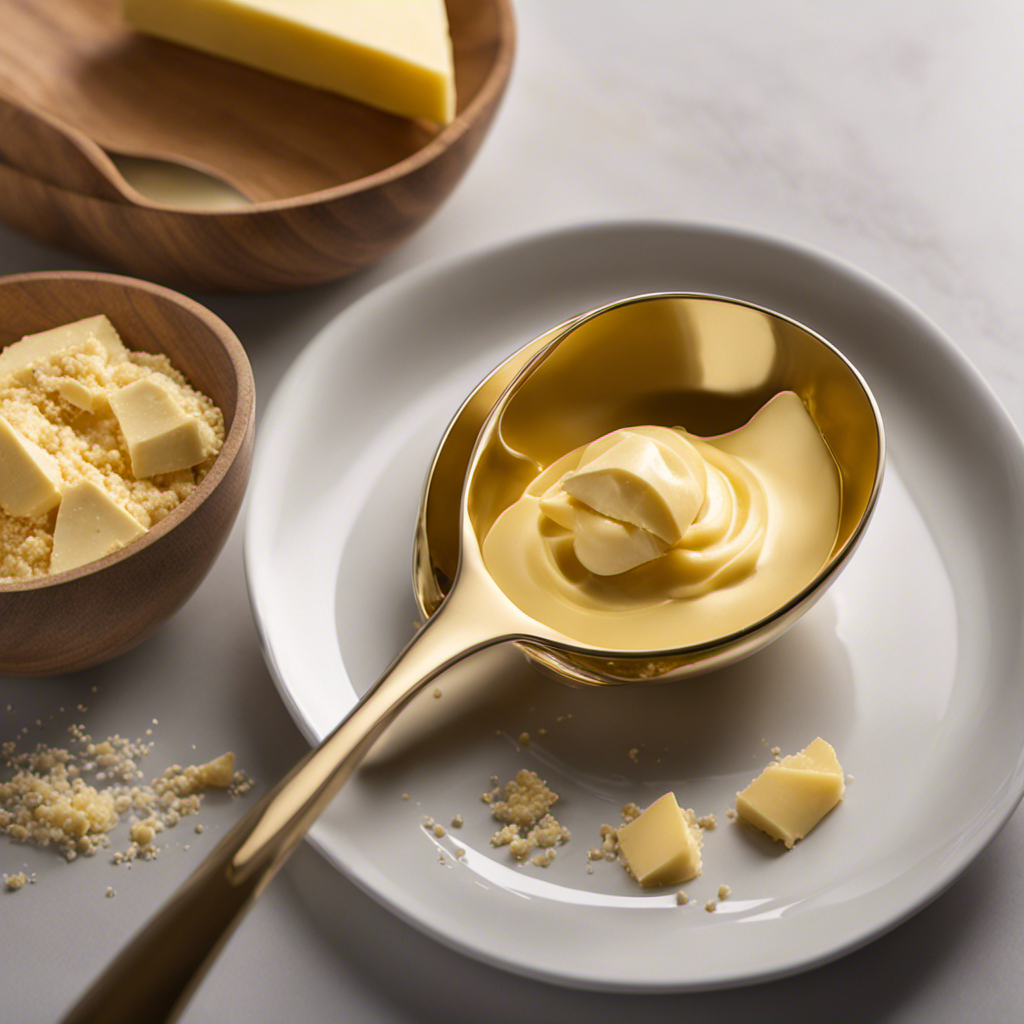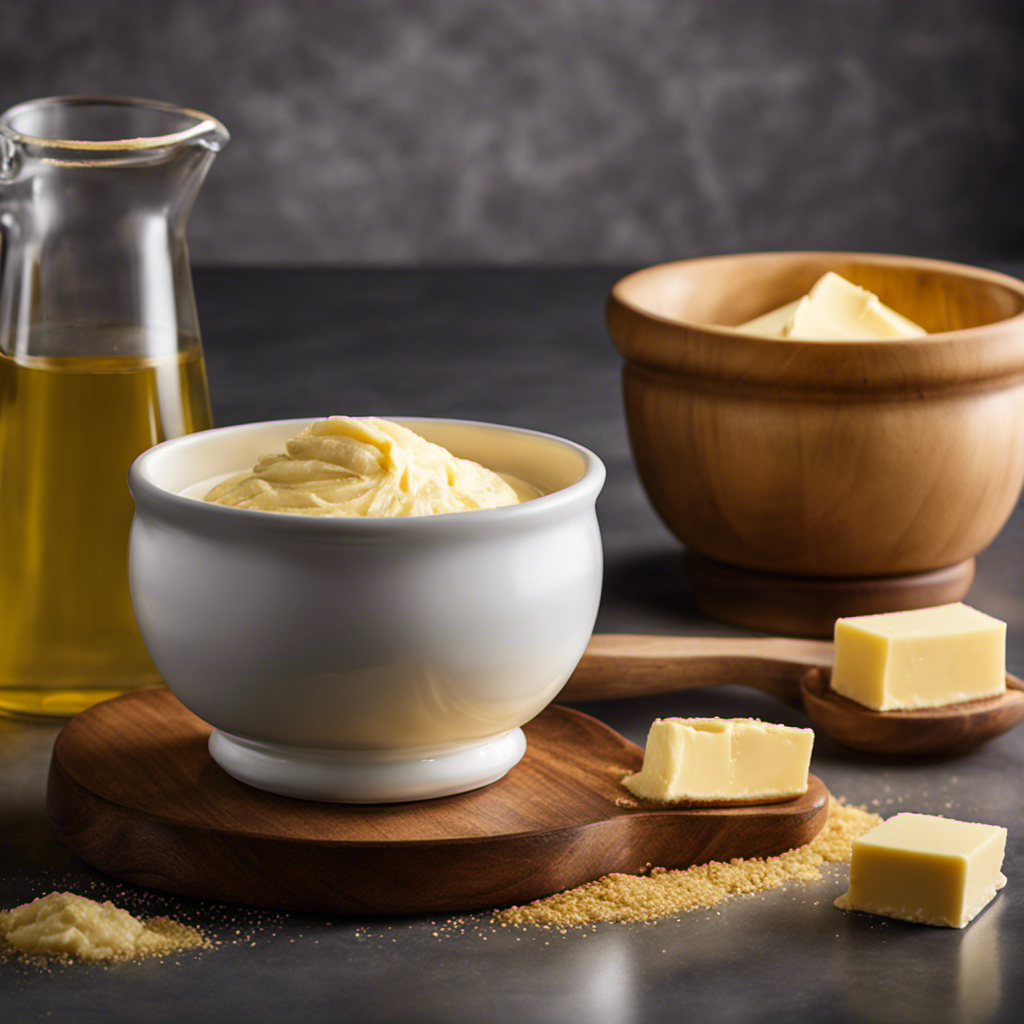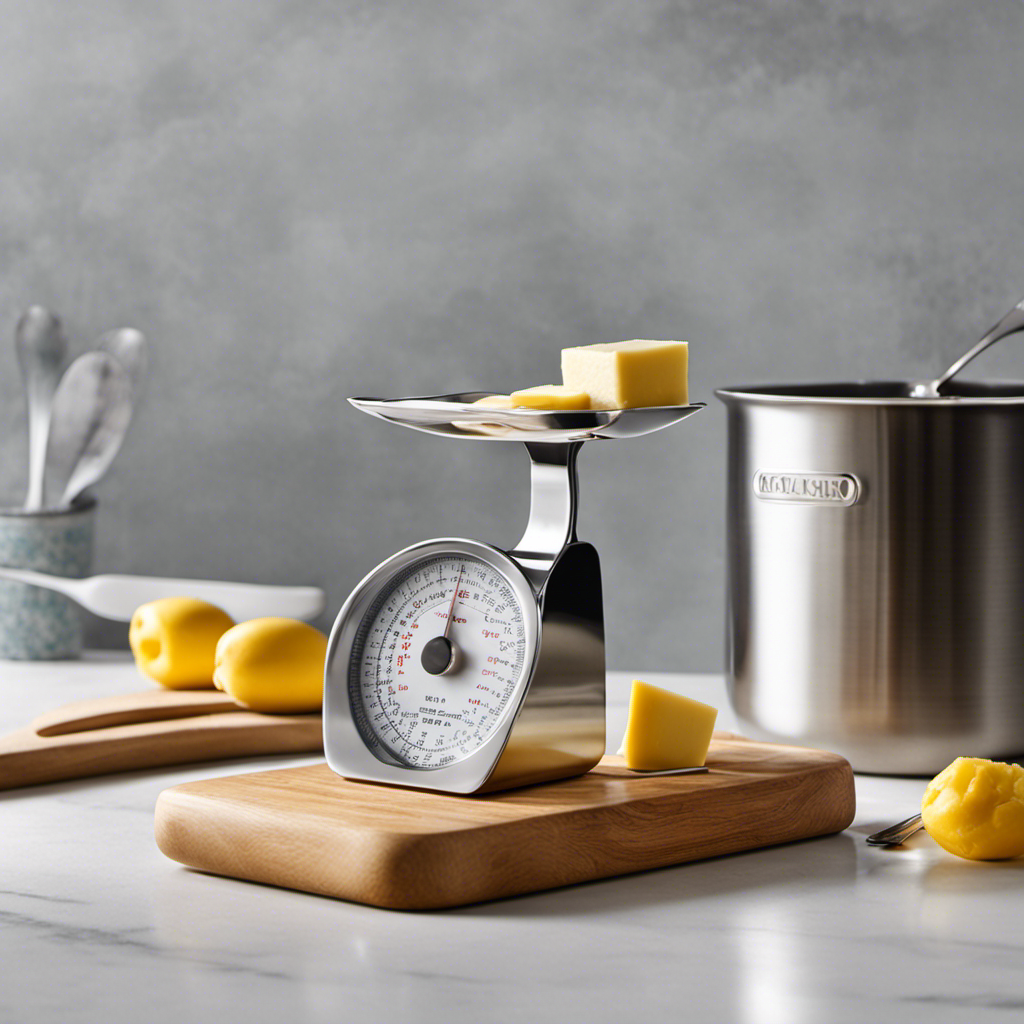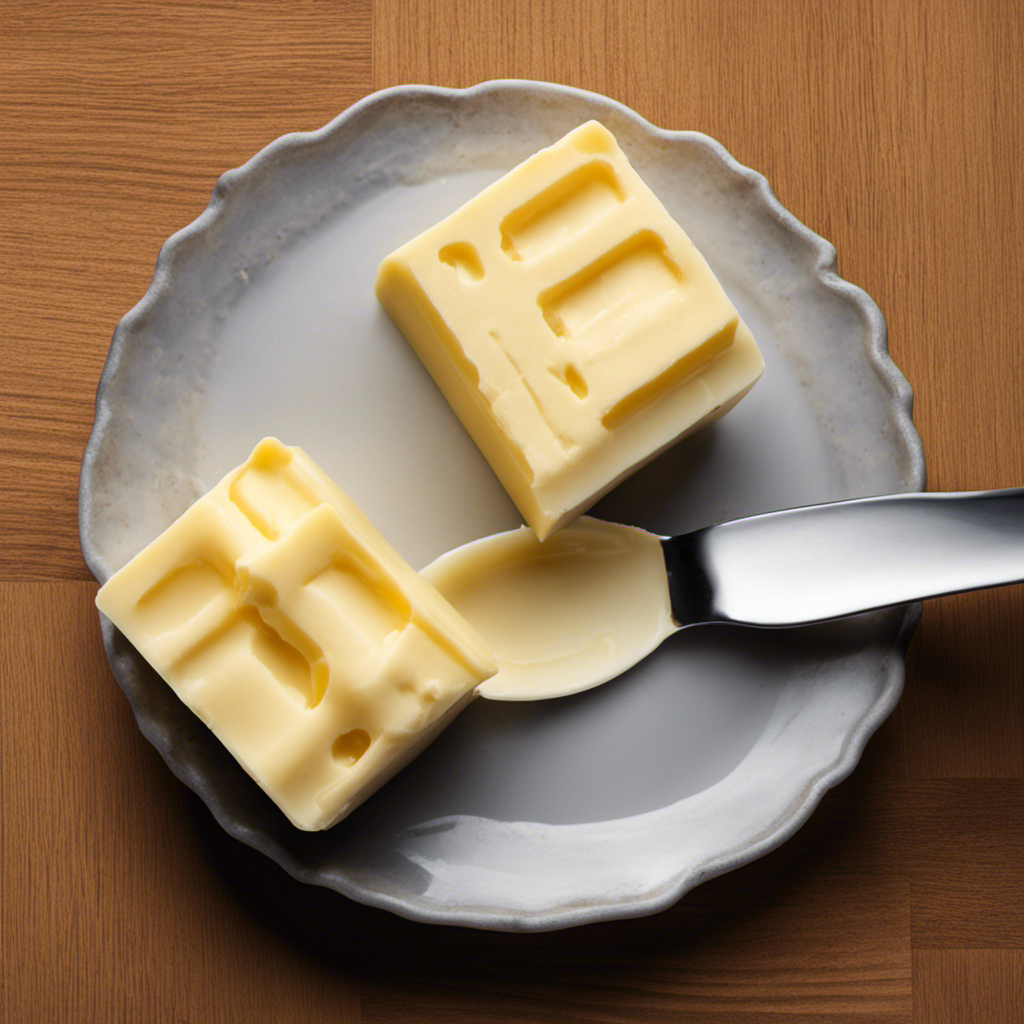If you're facing issues with butter-based frosting, you're not alone. For a grainy texture, switch to powdered sugar or sift it before use. If it's too sweet, try adding a pinch of salt or mixing in cream cheese for balance. Cold butter can lead to lumps, so always start with softened butter. To prevent melting, keep your frosting cool and avoid excess liquid. If your frosting is too soft, chill it briefly or add more powdered sugar. Tweak these elements to achieve your perfect frosting, and there's more to discover about troubleshooting your sweet treats effectively.
Key Takeaways
- Use powdered sugar to achieve a smooth texture and avoid graininess in your frosting.
- Adjust sweetness by adding a pinch of salt or incorporating cream cheese for balance.
- Ensure butter is at room temperature to prevent lumps and achieve a creamy consistency.
- Chill frosting briefly to firm it up if it's too soft or unstable.
- Fold in room-temperature butter or a small amount of milk to restore texture if overwhipped.
Common Butter-Based Frosting Problems

When it comes to butter-based frosting, several common issues can derail your cake decorating plans. One of the most frustrating problems you might encounter is a grainy texture. This often happens when the sugar isn't fully dissolved, so make sure you're mixing well and using powdered sugar for a smoother finish.
Another issue is the frosting being too sweet. If you find the flavor overwhelming, try adding a pinch of salt or incorporating some cream cheese to balance that sweetness.
Temperature can also be a culprit; if your butter's too cold, it won't blend well, leading to lumps. Let it soften at room temperature before you start.
You might also face a challenge with your frosting separating. This typically happens if the butter gets too warm or if you've added too much liquid. Stick to the recommended ratios and keep your ingredients at a consistent temperature.
Lastly, if your frosting's not holding its shape, consider increasing the amount of powdered sugar or using a higher ratio of butter.
Frosting Too Soft
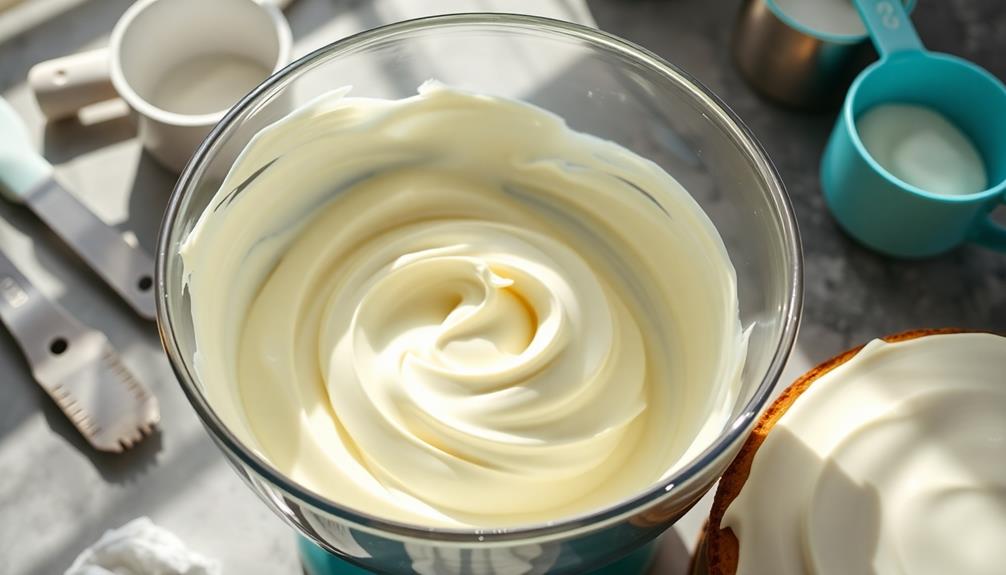
If your frosting's too soft, it's often due to a few common causes.
You'll want to check the temperature of your ingredients and consider some thickening techniques to fix the issue.
Let's explore these troubleshooting tips to help you achieve the perfect butter-based frosting consistency.
Common Causes Explained
One of the most common issues with butter-based frosting is its tendency to become too soft, which can be frustrating when you're aiming for a stable and spreadable texture.
Understanding the common causes can help you troubleshoot effectively and achieve the perfect consistency.
Here are three key reasons your frosting might be too soft:
- Too Much Liquid: If you add excessive milk or cream, it can thin out your frosting. Stick to the recipe's recommended amounts and only add more if absolutely necessary.
- Overbeating: While you want to whip your frosting to create air, overbeating can lead to a soft, airy texture that collapses. Mix just until ingredients are combined and it's fluffy.
- Insufficient Powdered Sugar: Powdered sugar not only adds sweetness but also helps stabilize your frosting. If you skimp on it, your frosting may lack the structure it needs to hold its shape.
Temperature Troubleshooting Tips
Temperature plays an essential role in the consistency of butter-based frosting. If your frosting turns out too soft, it might be due to the ingredients being too warm. Here are some troubleshooting tips to help you fix that issue.
| Situation | Possible Cause | Solution |
|---|---|---|
| Room temperature too high | Butter and cream are warm | Chill the mixing bowl and ingredients before starting. |
| Overmixing | Incorporating too much air | Mix on low speed and only until combined. |
| Not enough powdered sugar | Sugar absorbs moisture | Gradually add more powdered sugar until you reach the desired consistency. |
If you find your frosting too soft after mixing, try chilling it for about 15-30 minutes. This will help it firm up. Alternatively, you can place it in the refrigerator for a quick fix. Just remember to stir it gently before using, as refrigerating can cause it to harden too much. With these tips, you can achieve that perfect frosting consistency and make your baked goods shine!
Thickening Techniques Options
When your butter-based frosting ends up too soft, there are several techniques you can employ to thicken it up quickly.
Don't worry; with a few adjustments, you can get that frosting to the perfect consistency for spreading or piping.
Here are three effective thickening techniques to try:
1. Chill the Frosting: Place your bowl of frosting in the refrigerator for about 15-30 minutes. The cold will firm it up, making it easier to work with.
Just remember to stir it well after chilling.
2. Add Powdered Sugar: Gradually mix in more powdered sugar, one tablespoon at a time.
This not only thickens the frosting but also sweetens it, so taste as you go to avoid overpowering the flavor.
3. Incorporate Cornstarch: If you want a quick fix without altering the taste too much, add a teaspoon of cornstarch.
This will absorb excess moisture and help thicken the frosting without making it overly sweet.
Frosting Too Sweet
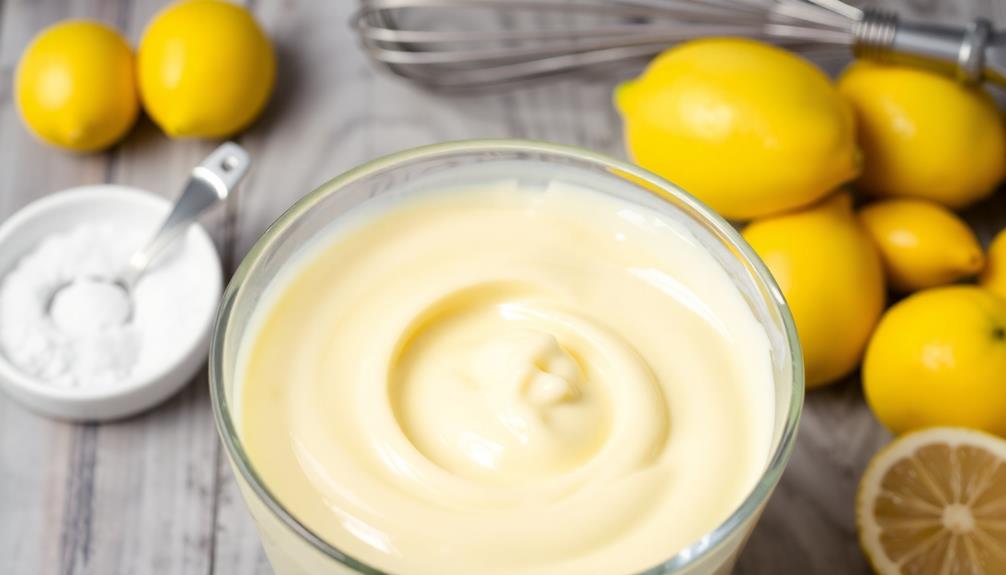
If your frosting's turning out too sweet, there are simple tweaks you can make.
You can adjust the sugar ratios, incorporate flavor enhancers, or even balance it out with a pinch of salt.
These changes can help you achieve a more balanced and delicious frosting.
Adjusting Sugar Ratios
Often, frosting can end up sweeter than you intended, leaving you searching for ways to balance the flavor. One effective approach is to adjust the sugar ratios in your recipe.
Here are three strategies you can use to reduce that overwhelming sweetness: Additionally, using higher fat content in butter can enhance the richness of your frosting, making it more flavorful and less reliant on sugar.
- Reduce Powdered Sugar: Start by cutting back on the amount of powdered sugar you add. Instead of the full cup, try decreasing it by a quarter or a third. This simple adjustment can greatly tone down the sweetness.
- Add Cream Cheese: Incorporating cream cheese into your frosting can provide a tangy contrast that balances out the sweetness. Aim for a cream cheese to butter ratio of 1:2 for a delightful texture and flavor.
- Incorporate Unsweetened Cocoa Powder: If you're making chocolate frosting, consider adding a couple of tablespoons of unsweetened cocoa powder. This not only deepens the flavor but also introduces a slight bitterness that can counteract the sugar's sweetness.
Experiment with these adjustments, and soon you'll have a frosting that perfectly complements your baked goods without overwhelming your taste buds.
Incorporating Flavor Enhancers
To elevate the flavor of your butter-based frosting without adding more sweetness, consider incorporating flavor enhancers that can transform the overall taste profile. Extracts like vanilla, almond, or even coconut can add depth and complexity. A simple teaspoon of vanilla extract can work wonders, giving your frosting a rich and inviting aroma.
You might also try incorporating citrus zest—think lemon or orange—for a revitalizing twist. Just a teaspoon can brighten up the frosting, cutting through the sweetness effectively. Additionally, flavored syrups, such as coffee or hazelnut, can deepen the flavor without making it overly sweet.
If you're feeling adventurous, a splash of liqueur, like amaretto or Grand Marnier, can add a sophisticated flair. Just remember, a little goes a long way, so start small and taste as you go.
Herbs and spices can also work wonders; a pinch of cinnamon or a hint of cardamom can add warmth and interest.
Experiment with these enhancers to find your perfect balance, and you'll create a frosting that's not just sweet but also bursting with flavor.
Balancing With Salt
Adding a pinch of salt to your butter-based frosting can work wonders in balancing out its sweetness.
It's a simple trick that can elevate your frosting from cloyingly sweet to perfectly delicious. Salt enhances flavors and can help create a more rounded taste profile, making your frosting enjoyable without overwhelming your palate.
To effectively balance your frosting, consider these tips:
- Start Small: Begin with just a pinch of salt. You can always add more if needed, but it's tough to take it out once it's in there.
- Taste as You Go: After adding salt, give your frosting a taste. This step is essential; you want to guarantee the sweetness is still present but not overpowering.
- Use Quality Salt: Opt for a good quality sea salt or Himalayan salt. These varieties can add a subtle complexity that table salt might lack.
Frosting Not Holding Shape
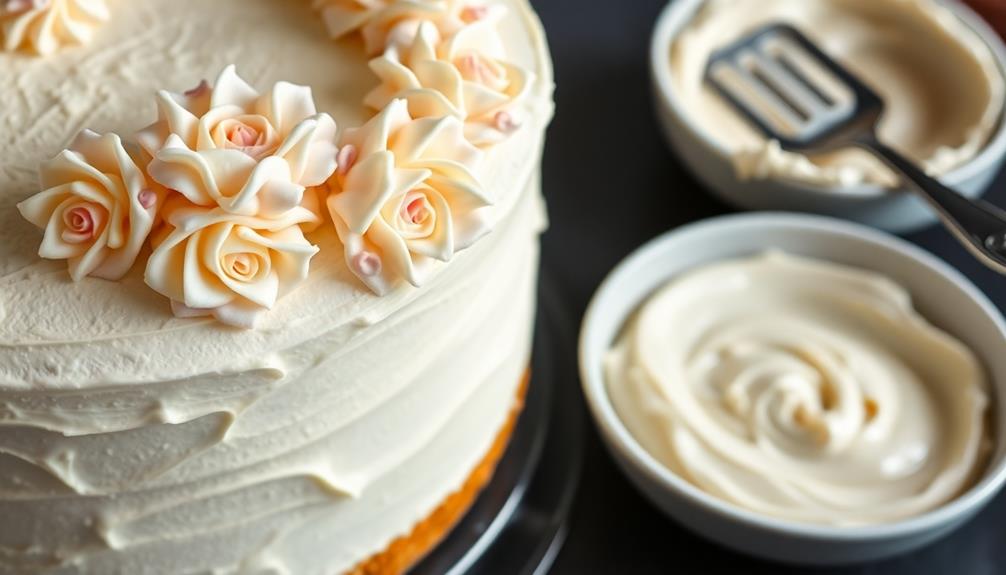
When you pipe butter-based frosting onto your cake, the final thing you want is for it to droop or lose its shape. If you find your frosting isn't holding up, there are a few common culprits.
First, check the temperature of your butter. If it's too soft, your frosting will likely be too loose. Ideally, your butter should be at room temperature—soft enough to cream but not melted.
Another factor is the ratio of ingredients. Make sure you're using the right balance of butter to powdered sugar. Too much liquid, such as milk or cream, can also make your frosting unstable. If you've added any flavorings or liquids, try reducing them slightly.
Consider adding a stabilizer like cornstarch or meringue powder. These ingredients can help your frosting retain its shape, especially in warmer conditions.
Finally, once piped, chill your cake for a bit to set the frosting. This can make a big difference in how it holds up over time.
Grainy Texture Issues
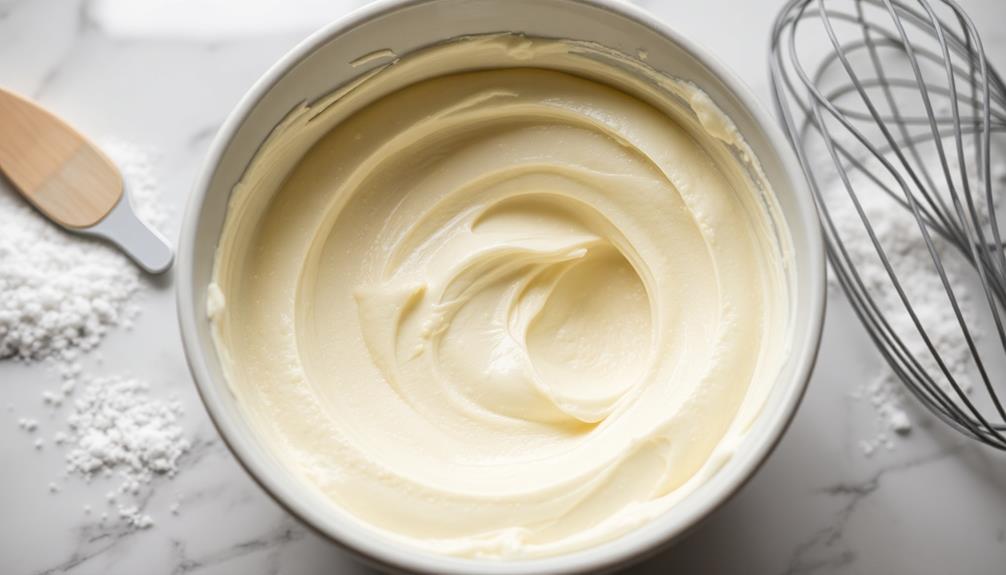
A grainy texture in butter-based frosting can be frustrating, especially when you're aiming for a smooth finish. This issue often stems from a few common culprits, but don't worry—there are ways to fix it.
- Butter Temperature: Make sure your butter is at room temperature before you start mixing. Cold butter doesn't incorporate well and can lead to graininess.
- Powdered Sugar Quality: Use high-quality powdered sugar, as lower grades may contain larger crystals that don't dissolve properly. If your frosting feels gritty, consider sifting the sugar before adding it to the mix.
- Mixing Technique: Be mindful of your mixing method. If you whip the frosting too aggressively, it can cause air pockets that contribute to a grainy texture.
Mix on low speed until the ingredients combine, and then increase the speed gently.
Color Fading or Dulling
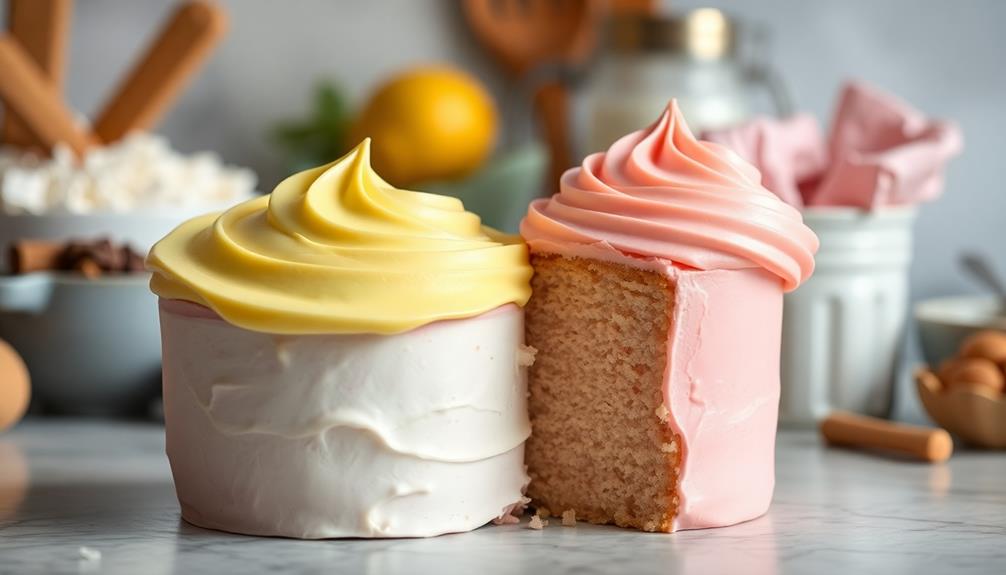
Color fading or dulling in butter-based frosting can be a common issue that affects the overall appearance of your baked goods. This problem may arise from factors like exposure to light, improper storage, or the use of certain colorants. To keep your frosting vibrant, consider these strategies:
| Cause | Effect | Solution |
|---|---|---|
| Exposure to sunlight | Colors fade quickly | Store cakes in a dark place |
| High temperatures | Colors can dull | Keep frosting cool |
| Use of natural colorants | Colors may not be vibrant | Experiment with gel colors |
Frosting Melting in Heat
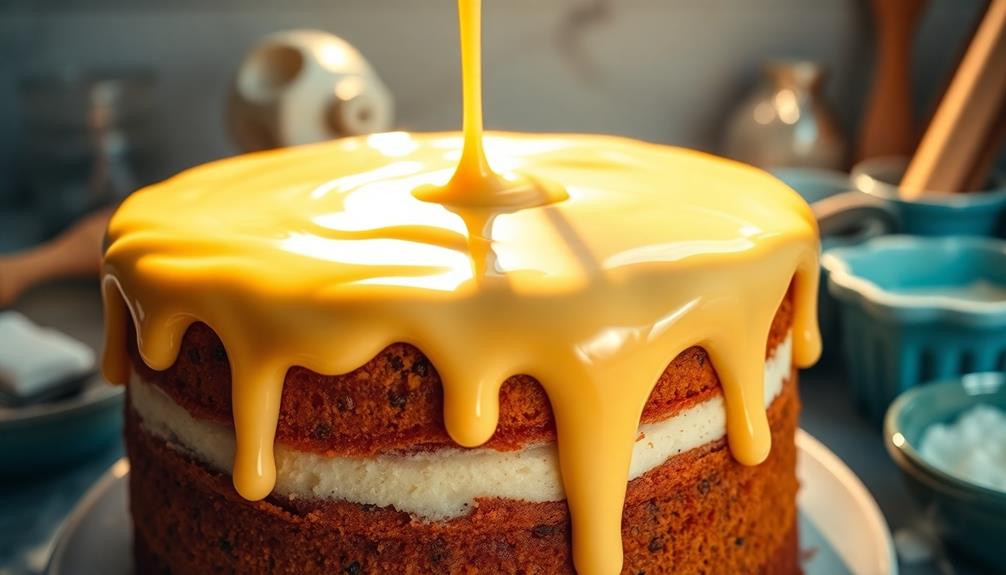
Buttercream frosting's worst enemy is heat, which can cause it to melt and lose its shape. When you're working in a warm environment, it's crucial to take precautionary measures to keep your frosting firm and beautiful.
For instance, using high-quality top butter brands can improve the overall stability of your frosting. Here are some tips to help you prevent melting:
- Chill Your Ingredients: Start with cold butter and keep your mixing bowl and beaters in the fridge for a bit before you begin. This helps maintain a stable temperature while you mix.
- Use Shortening: Consider substituting a portion of the butter with shortening. Shortening has a higher melting point, which can help your frosting hold its shape longer in warm conditions.
- Keep It Cool: When decorating, keep your cake or cupcakes in a cool area. If the room is too warm, you can even place your frosted treats in the fridge for a few minutes to set the frosting before serving.
Fixing Overwhipped Frosting
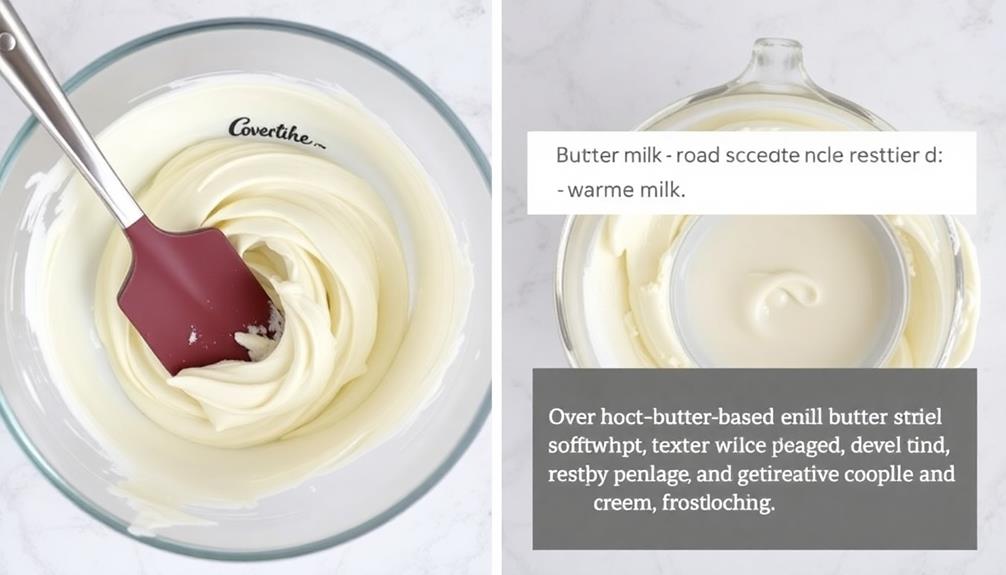
Overwhipped frosting can turn into a grainy mess, making it difficult to achieve that smooth, creamy texture you want. If you find yourself in this situation, don't worry; there's a way to fix it.
First, try gently folding in a bit of room-temperature unsalted butter. This can help reintroduce some creaminess and balance out the texture. If that doesn't work, you can add a small amount of milk or cream, mixing just until combined. Be careful not to overmix again.
Here's a quick reference table to help you decide how to fix your overwhipped frosting:
| Method | Description |
|---|---|
| Add Unsalted Butter | Fold in room-temperature butter to restore creaminess. |
| Add Milk or Cream | Mix in a small amount to loosen and smooth texture. |
| Rewhip Gently | Use a whisk on low speed to reintegrate ingredients without overwhipping. |
Storing Butter-Based Frosting

When you've whipped up a delicious batch of butter-based frosting, knowing how to store it properly is key to maintaining its freshness and texture.
Here's what you need to do to keep that frosting in tip-top shape:
- Refrigerate: Place your frosting in an airtight container. This prevents it from absorbing odors and keeps it moist. It can last up to two weeks in the fridge.
- Freeze: If you need to store it for a longer period, freezing is your best option. Portion it into smaller containers or use a freezer bag, removing as much air as possible. It can last up to three months in the freezer.
- Thaw Gradually: When you're ready to use your frosting, thaw it in the refrigerator overnight.
Once it's soft, give it a quick whip to restore its creamy texture before spreading or piping.
Frequently Asked Questions
Can I Use Margarine Instead of Butter for Frosting?
You can use margarine instead of butter for frosting, but it may alter the texture and flavor. Margarine's higher water content can make it less creamy, so adjust your recipe accordingly for the best results.
How Can I Add Flavor Without Affecting Frosting Consistency?
You can enhance flavor by using extracts like vanilla or almond. Just add a few drops at a time, mixing thoroughly. For a twist, consider incorporating citrus zest or cocoa powder to maintain smooth consistency.
What Tools Are Best for Whipping Butter-Based Frosting?
Did you know 70% of bakers prefer stand mixers for frosting? You'll find a stand mixer, whisk, and spatula are your best tools. They whip butter-based frosting to the perfect consistency and guarantee even mixing effortlessly.
Can I Freeze Butter-Based Frosting for Later Use?
Yes, you can freeze butter-based frosting for later use. Just scoop it into an airtight container, leaving some space for expansion. When you're ready, thaw it in the fridge and rewhip for best results.
How Do I Prevent Frosting From Sticking to the Piping Bag?
To prevent frosting from sticking to the piping bag, lightly grease the inside with a bit of vegetable shortening or spray. This helps create a smooth flow and makes cleanup much easier when you're done decorating.
Conclusion
Just like a ship sailing through turbulent waters, your butter-based frosting might encounter a few storms. But with the right techniques, you can navigate those challenges and reach the sweet shores of perfection. Whether it's softening, sweetening, or shaping, remember that each issue is just a wave to ride. So grab your whisk and set sail with confidence, knowing that with a little adjustment, your frosting will shine brightly like the sun over a calm sea.
